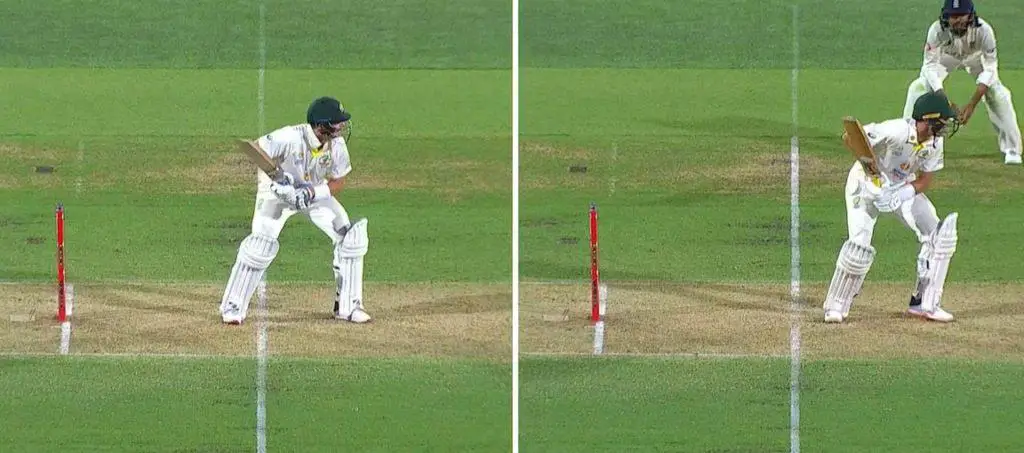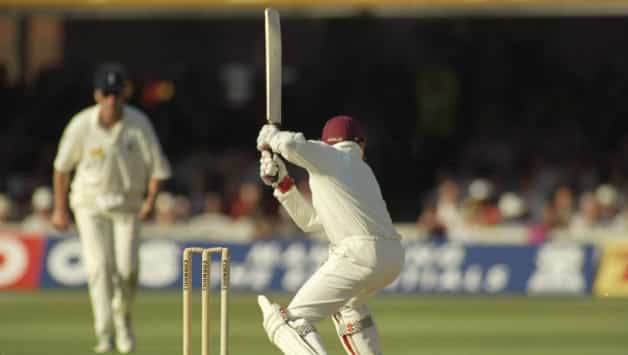If you’re a batsman in cricket, there are so many aspects of your technique that you may want to work on over the course of your career. Trigger movements, the batting stance, the way you grip the bat and the position you get your head in are just a few of these – and I’ve covered the fundamentals of most of them here on the site!
When working on your game, or when analysing other players, you may hear coaches or commentators mention the term ‘backlift’ to you. This is another aspect of batting technique that many players like to tinker with and change as they gain more experience. If you’re not sure what a backlift is, or why it’s important, then this post is for you. Let’s get into the main question first…
What is a backlift in cricket?
The term ‘backlift’ in cricket refers to how high the batsman raises their bat behind them before they swing it downwards to hit the ball. Some batsmen have high backlifts, with the toe of the bat going well over head height, and some batsmen have low backlifts, where the toe of the bat barely reaches shoulder height.
It’s worth noting that a batsman’s backlift can also often be referred to as their ‘backswing’. So, if you hear commentators or coaches using both of these terms, be aware that they are probably referring to exactly the same thing!
To explain the term backlift a little better, I thought it would be necessary to include a few pictures as an example, and you can see these below.

Picture 2: Root prepares to begin the downswing in order to play the shot
Picture 3: Downswing is now complete, contact has been made with the ball
Joe Root has a wonderfully rhythmic technique that features many subtle movements before he plays the ball, but as you can see in the photos, he does not have an extraordinarily high backlift. I’d say Joe’s backlift height is about average for most professional batsmen. Once he has executed his backlift, he moves into the ‘downswing’ period of the shot, which is basically the period in which the bat is swung downwards to make contact with the ball.
Why Is The Backlift Important?
Now that you know what the backlift is, some of you may be wondering how it makes a difference to a batter’s technique and why they would ever choose to change it. Well, fear not – I have the answers you seek. In my opinion, there are three main reasons that the backlift is so important to batsmen. They are as follows:
- It helps them generate power
- It helps a batsman to generate rhythm
- Different backlifts can help a batsman cope with different conditions and bowlers
Let’s have a look at each of these reasons individually and examine exactly why the backlift helps with each of them.
Why Can A Backlift Help A Batsman Generate Power?
In my opinion, this is the number one reason that the backlift is critical to a batting technique. It is one of the things that helps us to get as much power as possible into our shots. Generally, the higher the backlift, the more force a player can put into a shot. Obviously, this isn’t the only factor that influences how powerfully a batsman can hit a cricket ball – but it definitely plays a part!
To explain why this is the case, imagine playing a shot without lifting your bat up behind you at all. You can even try this out if you have a bat and a ball available to you! As you can probably guess, it would be impossible to hit the ball with your usual amount of power if you weren’t allowed to use any kind of backswing whatsoever. To use a slightly different example, imagine trying to hit a golf ball as far as you possibly could. To do this, you would need to raise the club a long way behind you (backlift), and then accelerate through the downswing in order to make contact with the golf ball. Again, it would be impossible to strike the golf ball as far if you did not raise the club behind your head.
So, when a batsman has a large backlift, this gives them a large distance in which they can swing the bat downwards in order to make contact with the ball. The faster the downswing and the more they accelerate their hands through the contact with the ball, the more power they will usually be able to get on their shots.
Why Does A Backlift Help With Batting Rhythm?
For many players, batting is all about getting into a good rhythm at the crease. Ensuring that your trigger movements happen at the correct moment and your front foot moves towards the ball early enough is critical for success. The backlift is also part of this process!
Think about it, if your backlift happens too early, you will be holding the bat up in the air and waiting to bring it down for an unnatural amount of time. No batsman wants to be pausing for too long at the top of their backlift. Now imagine the opposite. If your backlift happens too late then you aren’t going to have enough time to swing your bat downwards and make contact with the ball. If this does occur, you can end up getting in a horrific tangle and having to rush through all of your movements – not exactly ideal!
The best backlifts are ones that are very repeatable – meaning they don’t change radically from ball to ball, and ones that sync up nicely with the movement of your feet. To achieve a repeatable pre-delivery batting process, you will have to settle on a backlift and a set of movements that suit you and feel natural. Once you have a process that you’re happy with, stick with it and ingrain it into your muscle memory through hours and hours of practice!
How Does A Backlift Help A Player Cope In Different Conditions?
There are certain conditions which suit different types of backlifts, and over the years many professional players have tried to make subtle adjustments to their backlift height in order to put them in better positions to succeed in tough batting conditions.
High backlifts are suited to hard, bouncy pitches like the ones you’ll see a lot of in Australia and South Africa. In these countries you will often end up playing on the back foot more than you would in other nations. Therefore, a backlift that helps you to get your hands and your bat up high before you strike the ball helps you when playing hook, cut and pull shots on these kinds of surfaces.
Lower backlifts are often suited to countries where the ball bounces lower such as Pakistan or Sri Lanka, as this can help a batsman to get their hands and bat a bit closer to the ball if it bounces slightly lower than usual. I also remember hearing about Michael Atherton switching to a low backlift when playing against excellent bowlers like Wasim Akram and Waqar Younis, who were great reverse swingers of the ball and bowled a lot of yorkers. Against bowlers that bowl plenty of yorkers, overly high backlifts aren’t ideal because the bat has to travel a long way in order to jam down onto the ball.
Does The Direction Of A Backlift Matter?
If you follow the sport of cricket then you’ll know how many different batting techniques there are, and by reading this post hopefully you’ve learned that there are many different heights of backlift too. However, in addition to the different heights, batsmen’s backlifts can also point in different directions! Does this matter? Is there a right way to do things? Let’s have a quick look below.
A conventional backlift in the game of cricket is often said to be one where the toe of the bat points somewhere in between the wicket keeper and first/second slip. This is considered by many professionals and coaches to be ‘technically correct’ because it allows the bat to be brought through relatively straight during the downswing. This helps when it comes to hitting straight balls.
However, there are many batsmen that have backlifts that point in dramatically different directions. Take Steve Smith for example. He has an incredibly unorthodox technique, and his backlift actually points more in the direction of the gully fielder, rather than in the ‘conventional’ direction that I mentioned above. Steve Smith is one of the most successful modern test batsmen, and is living proof that an ‘orthodox’ technique is not required in order to succeed at the highest level. Marnus Labuschagne’s backlift also points in a similar direction – and you can see that below.

To summarise this section – no, the direction of your backlift does not necessarily matter. However, there are certain advantages and disadvantages of having a straighter backlift compared to ones that are angled towards the gully or point region. If you have a slightly more unorthodox backlift, you will need to practice a lot and learn what sort of shots/habits you should avoid when batting.
Which Players Have Had Very High Backlifts?
Whenever I talk about players with high backlifts – I always have to mention Brian Lara. Lara is undoubtedly one of the best batsmen ever to play the game, and was known for his flamboyant strokeplay just as much as he was known for his ability to compile world record amounts of runs.
Lara’s backlift extended well above head height, and you can see this in the picture below. This incredibly high backlift led to bowlers like Andrew Flintoff targeting him with fast, full balls early in his innings in the hope that he would not be able to get his bat down in time to block the ball.

When Lara was at his best, his high backlift added an extra bit of flair to his exciting array of strokes.
Which Players Have Had Very Low Backlifts?
A couple of players who have utilised lower backlifts are guys like ex-Australia captains Mark Taylor and Allan Border. Both of these players believed that having lower backlifts enabled them to combat conventional swing bowling and especially reverse swing bowling with increased success, even though it may have denied them some boundaries over the course of their careers.
Conclusion
I hope that this post provided you with the information about cricket backlifts that you were seeking! When looking at a batsman’s technique there are hundreds of things that it is possible to comment on, and the backlift is certainly an important part of that. If you want to get more of my thoughts on current batsmen and bowlers and the techniques they use, I do several pieces of analysis on my Instagram page which you can access by clicking here! I’ll be making this more of a regular thing going forward, so if you’re interested in that, make sure you follow me on there!
Also, if there are any particular bowlers or batsmen who have techniques that you’d like me to examine – drop me a comment on one of my Instagram posts and I’ll see what I can do!
